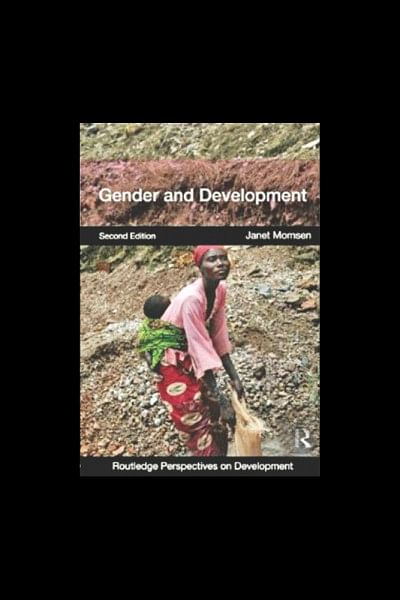Gender and Development By Janet Momsen

GENDER and Development by Janet Momsen (2009) is an empirical study considering position of women in developing countries. This book is a cornerstone in critical development studies divided into nine chapters emphasizing on gender complexities in Millennium Development Goals; social and biological reproduction; differences in health and violence at major life stages for women and men, as well as natural disasters and gender roles in rural and urban areas. The conceptual framework of the book proposes the impact of broad economic changes such as the globalization of trade and communications on gender differences in economic activities addressing international progress towards gender equality.
Momsen argues global development processes affect adversely on women because of their absence in development mechanism and its implementation process. It is claimed that modernization of agriculture and gender division of labour in the production process in rural regions keep women far away from receiving the outcome of the development interrogating gender relations in terms of the way development policies change the balance of power between women and men. This in turn causes potential differences in the proportions of men and women in national and regional populations' distribution, changes in gender differences in life expectancy clarifying fundamental reasons for gendered patterns of migration.
Eco-feminism establishing the roles of women in natural environment, how gender differences affect environmental security with regards to extreme weather events such as Aila and Sidr and how its consequences are gendered has been particularly mentioned in middle section of the book. In establishing this agenda, how natural resourses' use is gendered is clearly discussed considering Global Assembly of Women and Environment held in Miamia in November 1991, the global forum held in Reo deJaneiro in June 1992, Johannesburg conference. The impacts of development on gender roles in agriculture, time use in rural areas, regional differences in gendered employments in agriculture and newtypes of rural employments. It is argued that ownership of recourses in land, training and modern inputs is always gender biased giving more preferences to men compared to women. By contrast, various studies have shown that if women had these accesses equally as men then harvests from women's farms would be equal to or greater than those from men's farms.
In addition, female marginalization in employment, the links between urbanization and modernization, the importance of the spatial separation of home and work in urban areas has been articulated. The author suggests that women's role in production becomes progressively less central and important during capitalist industrialization. The physical weakness, moral danger, lack of facilities for women workers and their security are the major concerns of their marginalization both in governmental or private sector. Feminist theorists claim that social and cultural factors are restricting women's access to the labour forces.
The book captures the influence of globalization on gender differences in economic activities over the life course; recognizing the new types of employment for women provided by TNCs and EPZs; appreciating the problematic nature of microfinance and making aware of tourism and social catalyst. But it is true that globalization, articulated by transnational companies has created a new market for women's employment. Apparently women's employment patterns vary by age from country to country more than men's. Microfinance as small scheme offers opportunities for women to develop entrepreneurial skills but, indirectly causes feminization of debt. By contrast, the extent of progress in gender equality, gender roles in politics and the value of quotas, the gendered impact in material assets and individual well-being has been discussed in the context of global south. The author argues how the ratification of international policy documents (e.g., CEDWA) and conferences occurred during 1975 to 2005 have encouraged women's rights. With this regard, developing countries introduced quotas to improve gender balance in politics to be effective into local level policy-making. Also the authors pin point how poverty forces people to increase their active involvement in the market economy, to migrate, to cut back on education and to seek a range of survival strategies.
The reviewers Sajal Roy is Lecturer in Women & Gener Studies, Begum Rokey University, Rangpur and Arunima Kishore Das is a Masters Candidate, Department of Women & Gender Studies University of Dhaka.

 For all latest news, follow The Daily Star's Google News channel.
For all latest news, follow The Daily Star's Google News channel. 



Comments